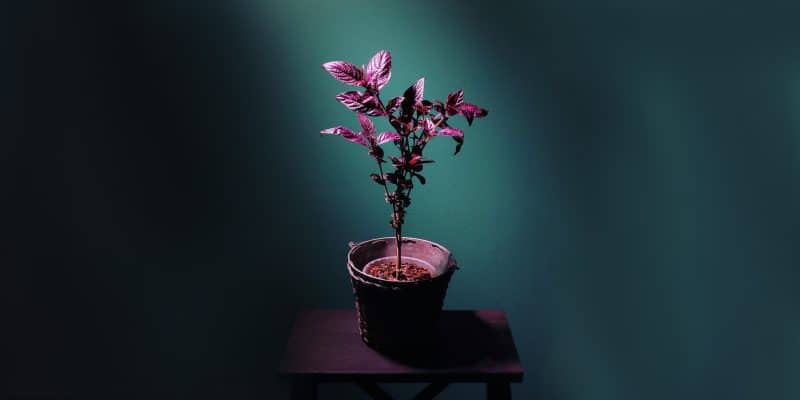Persian shield (Strobilanthes dyerianus) is a regal houseplant with shimmering, iridescent purple leaves that add a touch of dazzle to any space.
Its vibrant foliage really sets it apart from other houseplants. Best of all, Persian shield isn’t too hard to keep satisfied, other than frequent watering and lots of bright light.
In this comprehensive Persian shield care guide, we’ll unveil the secrets to keeping your plant happy and thriving, covering everything from lighting and watering to temperature, humidity, and even propagation.
We’ll also address common issues that may arise with your Persian shield and how to remedy them.
Let’s get growing!
Table of Contents
Persian Shield Care Guide
History, habitat, and characteristics
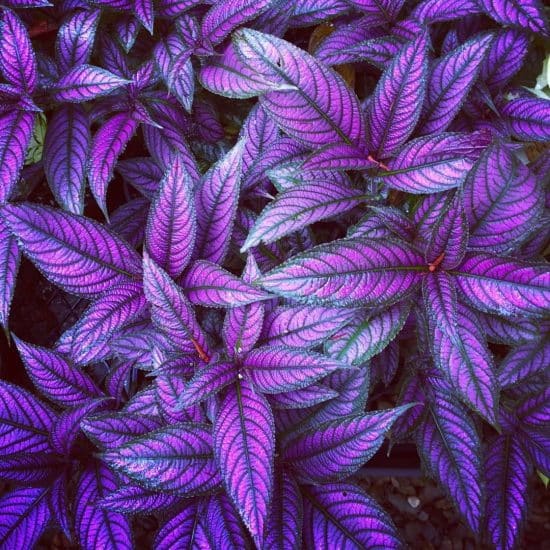
The Persian shield, also known as Strobilanthes dyerianus, is from the Acanthaceae family and comes all the way from the tropical rainforests of Myanmar (nope, not Persia!).
Strobilanthes is a combination of the Greek words strobilos and anthos, meaning “cone” and “flower,” respectively . . . so we have “cone flower,” alluding to the cone-like shape this plant’s flowers take. (Before you ask — yep, they’ll bloom as houseplants under the right conditions, but it’s actually best to remove the flowers to prevent your plant from getting leggy).
The Latin dyeriana part honors the English botanist Sir William Turner Thiselton-Dyer (there it is!) who was the director of the Royal Botanic Gardens in Kew for 20 years.
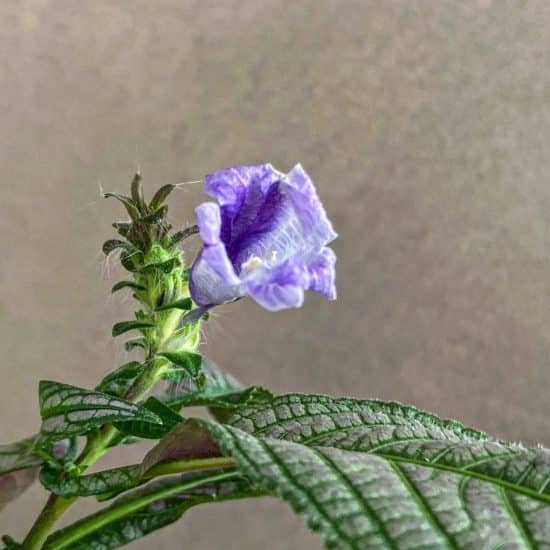
What’s so special about it? Well, its vibrant combination of purple flowers & foliage is like no other. In fact, it’s the reason this beauty has earned the nickname royal purple plant.
You know how people say we get better with age? For the Persian shield, it’s quite the opposite! When young, this plant’s leaves are a jaw-dropping iridescent purple that will light up any room. But as they age, the leaves turn more subdued (just like some of us, right?) as the plants grow woodier.
Because of this reason, after it gets mature, many people choose to propagate new plants to show off that dazzling purple shine.
Fun fact: The Persian shield was introduced to Europe in the early 20th century by Sir Henry Walton, a British botanist. After discovering it in Myanmar, he brought it back to England, and now we get to enjoy this amazing houseplant too!
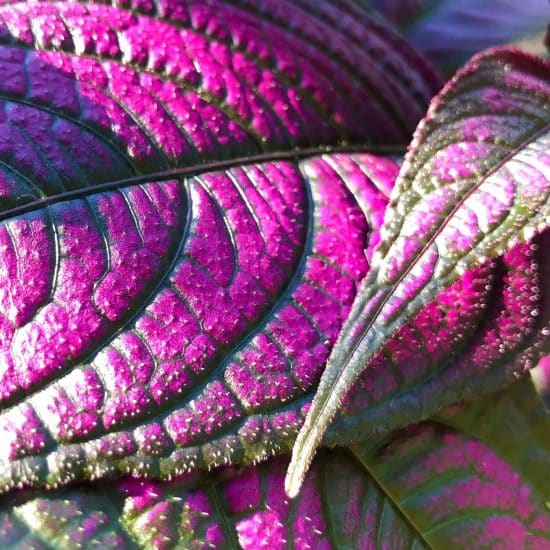
Back to the Persian shield’s lance-shaped, saw tooth-edged leaves. They remind many of reptile skin — paper-thin, fragile, and delicate, with veins that make them look almost quilted. Quirky, huh?
Oh, and let’s not forget the fine hairs on the leaf tops (called trichomes) that help protect it against sun, water loss, and pests.
Let’s dive into the ideal environmental conditions for this shimmery purple wonder.
Light
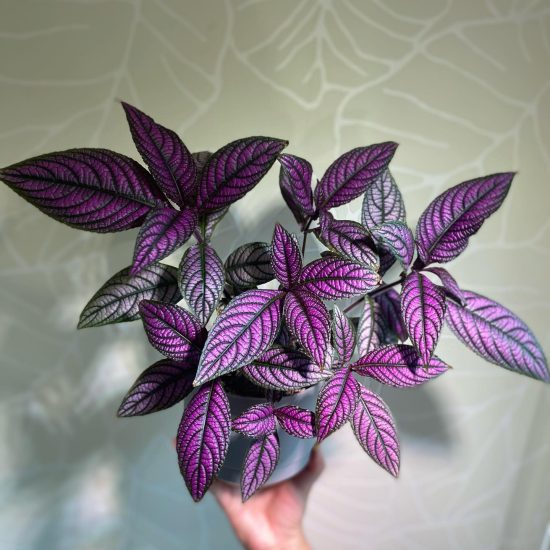
The Persian shield craves bright light, which helps it grow fast and maintain that beautiful purple hue. Outdoors, it grows best in dappled light like the type found under the jungle canopy in its native habitat.
Indoors, it actually needs a little bit of direct light to keep its purples vivid. But too much direct sunlight, especially in the afternoon, is a no-no, since it can harm those delicate leaves. The trick is finding that sweet spot where your Persian shield plant can flourish without turning its leaves into sunburnt crisps.
So, how do you tell if your Persian shield isn’t getting enough light, or if it’s getting a bit too much? Here are some clues to look for:
Not Enough Light?
If your Persian shield is struggling in a dim spot, you’ll likely see leaves turning a sad shade of yellow or pale instead of that mesmerizing purple, and weak leaves that may even surrender and fall off.
Sound familiar? Time to move your plant to a brighter area.
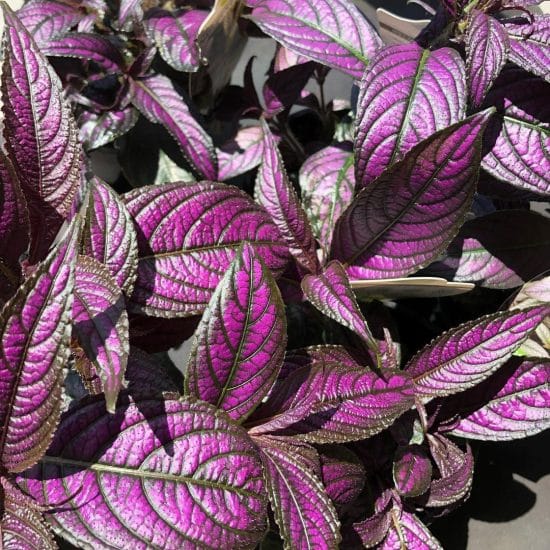
Too Much Light?
On the other hand, if your Persian shield is getting a sunburn, watch for leaves that fade and lose their iridescent glow. You also might see tiny holes, burns, or scorched edges on the leaves.
If you spot these signs, take it as a cue to find a shadier spot for your plant pal.
Persian shield light tips:
- Find a spot near a window that offers bright, mostly indirect sunlight (an east-facing window works great)
- Use sheer curtains to tone down any harsh rays, especially in the afternoon
- Give your potted plants a little rotation every few weeks, so all its leaves can bask in that lovely light
Just think of your plant as your stylish, diva-like roommate who loves to be in the limelight . . . but not too much direct light!
Water
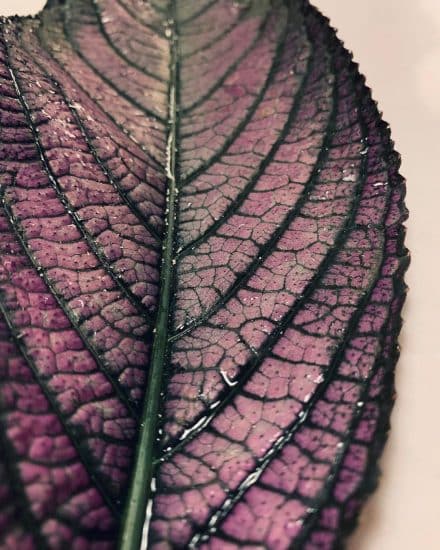
Growing Persian shield indoors can be pretty thirsty work, since it sometimes needs daily watering.
Now, if it’s hanging out in a sunny spot, you might even find that your Persian shield plant craves water twice a day. Remember, every home is a little different, so just keep an eye on the conditions where your plant is living.
Giving your plant too little water can be a bummer. How do you know if it’s thirsty? Well, if the leaves start to wilt, their edges become crispy and dry, or the plant’s silvery foliage loses its iridescent sheen, that’s a hint it might need more water.
On the other hand, too much water can spell trouble, too. If the leaves turn yellow or the entire plant looks a bit droopy and soggy, you’re probably overdoing it with the watering can. Just let the soil dry out a bit and tweak your watering routine to find the sweet spot.
Temperature and humidity
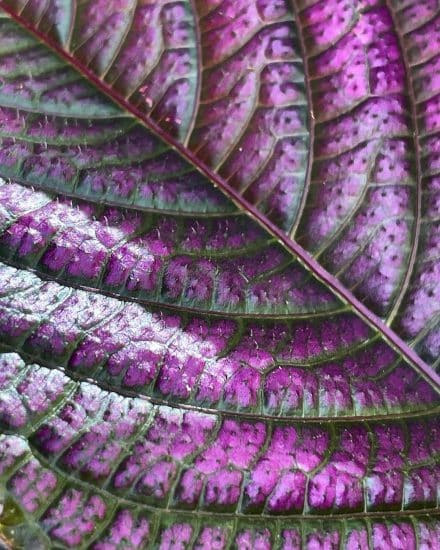
To grow Persian shield successfully and have it thrive, providing the right temperature and humidity conditions is crucial.
Since it’s a tropical plant that grows in USDA zones 10 and 11, the Persian shield prefers warm temperatures, ideally between 65-80°F (18-27°C) to mimic its natural environment and encourages healthy growth.
When it comes to temperature fluctuations, the Persian shield can be sensitive. Position your plant away from drafty windows or doors, as well as from direct heat sources like radiators or heating vents.
Now let’s talk about humidity. Persian shields truly love humid conditions, and providing a humid environment will prevent the plant from dropping too many leaves. Strive for humidity levels between 40-60% around the plant.
If you notice your Persian shield’s leaves curling, drooping, or developing brown edges, it might be a sign of too little humidity.
Need to raise it? No problem.
Persian shield humidity tips:
- Place a pebble tray with water beneath the pot
- Put a humidifier nearby
- Group your Persian shield with houseplants that have similar humidity needs so they can share moisture
Soil and Planting
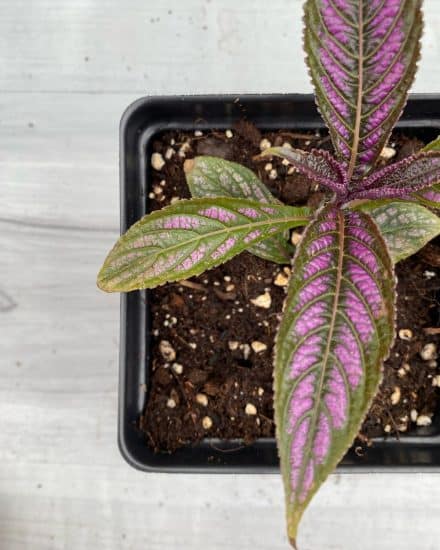
The Persian Shield plant thrives in a fast-draining potting mix that can provide the right balance of moisture and air circulation.
If you want to go the store-bought route, these guys will love an aroid potting mix . . . or a forest floor mix, which uses components that mimic those found on the rainforest floor, like earthworm castings.
Alternatively, you can make your own mix amended with perlite and peat moss, but be sure to water less frequently in that case to avoid root rot. Our recommended mix is:
- 33% high-quality rich soil
- 33% perlite
- 33% peat moss or coco coir
If the soil is too dense and doesn’t drain well, it can cause waterlogging and rotting roots.
On the other hand, if the soil drains too quickly and doesn’t retain moisture, the entire plant may suffer from dehydration and nutrient deficiencies. Signs that your Persian shield may be suffering from poor soil conditions include yellowing leaves, wilting, and stunted growth.
If you note any of these and you’ve ruled out other culprits, switch to our recommended mix!
Pruning Persian shield
Persian shields lose their color as they older. If this happens, or if your plant becomes leggy, feel free to take stem cuttings that you can use for propagation, and get rid of the mother plant (sounds harsh, but it’s okay, we promise!).
A note: Sometimes the stems of this plant can get so tall they flop over, so you might want to pinch new leaf buds off right away when the plant is small so it’ll branch out more.
Fertilizing Persian shield
Persian shields benefit from regular fertilizing during their growing season. Apply a balanced liquid plant food diluted to half strength every two to four weeks from spring to early autumn. Avoid fertilizing during the winter months, since it’ll be dormant then and won’t need the nutrients.
Too much fertilizer can lead to brown and yellow tips and edges, as well as stunted growth. If you suspect this, thoroughly flush the soil with water to remove excess nutrients. Use more diluted fertilizer and/or fertilize less in the future (follow the instructions on the label!).
Repotting Persian shield
Persian shield plants can benefit from repotting every couple of years, especially if they’ve outgrown their current container. The best time to repot is during the spring when the plant is actively growing and can better handle the stress of being transplanted.
Choose a new pot that’s only slightly larger than the current one, and be sure it has ample drainage holes to prevent waterlogging.
Propagation Guide: Persian Shield
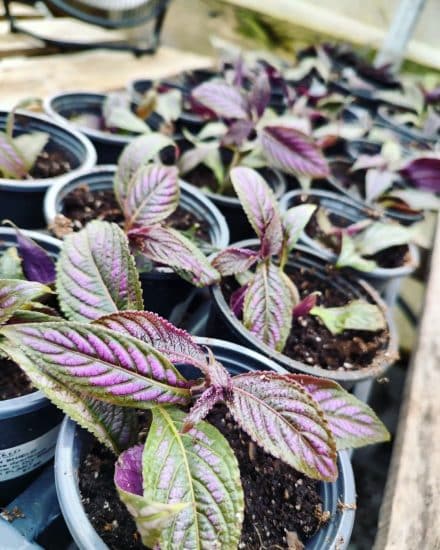
Are other people getting jealous of your Persian shield’s shimmery purple foliage and demanding you propagate more for them? It happens.
You can propagate Persian shield from seed and stem cuttings. It can be hard to find seeds, so most people opt for stem cuttings. Propagating stems in soil works much better than water for these guys.
Propagating Persian shield by stem cutting:
- Pick a healthy stem: Start by finding a nice-looking 4-6 inch long stem on your mother plant, one with several leaves and woody stems.
- Snip the stem: Grab your sterilized pruning shears and give that stem a little haircut just below a leaf node. (No need to be nervous; you’re helping the main plant to create more lower branches, and it’ll thank you with some awesome growth).
- Get the cutting ready: Take off any leaves from the bottom 1-2 inches of the stem cutting —leaving them on might make the cutting rot, and that’s the last thing we want!
- Plant your new baby: Grab a small pot filled with well-draining, rich potting mix and gently place the prepared cutting into it, burying those exposed nodes. Give the soil a little pat around the stem, like you’re tucking it into bed.
- Keep it moist: Position the pot in a bright spot with dappled sunlight, but watch out for full sun — it might be too harsh for the young cutting. Water the plant regularly so the soil stays evenly moist, like a damp sponge but not a soggy mess.
- Watch it grow: Over the next few weeks, your little cutting will start to develop roots and new leaves. Once that happens, you can slowly cut back on the watering (just a bit!) and give it more light as it grows stronger.
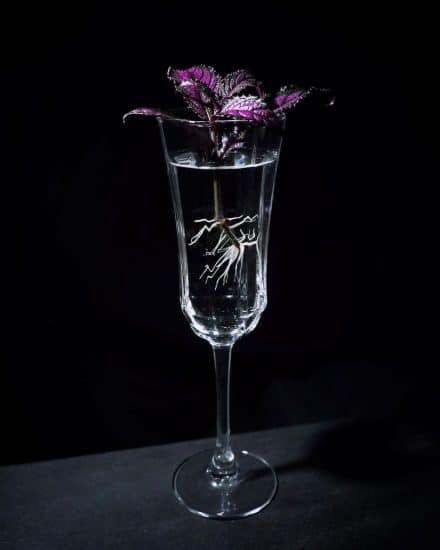
And that’s it! With these steps and tips, you’ll have a new Persian shield to show off in no time. Happy propagating!
Common Issues
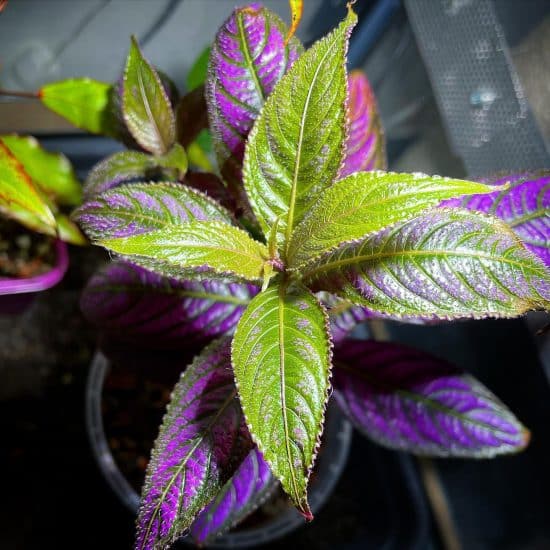
Let’s chat about some common issues your Persian shield plant might face, especially in cooler climates.
Wilting Leaves
Issues with wilting are likely due to underwatering, making those once vibrant flowering plants lose their oomph.
Getting those leaves perky again is as simple as giving your Persian shield the drink it’s craving. Just make sure to keep the soil consistently moist (but not sopping wet) by watering when the top inch feels dry.
And don’t forget about lighting – your plants need plenty of indirect sunlight to really thrive. Too much full sun, however, may cause the leaves to burn and wilt, so if this is the case, filter it with a curtain or move your plants from the window back a few feet.
Crispy Edges
It’s like when you accidentally overcook the edges of a delicious brownie . . . but for your Persian shield. Dry, curled, and brownish edges on the leaves are a cry for help, often signaling underwatering, low humidity, or potential spider mite infestation.
Luckily, there’s an easy fix! First, check your watering schedule and make sure you’re keeping the soil moist consistently.
Next, boost the humidity around your indoor plants by placing a pebble tray or humidifer nearby. Oh, and double-check that your Persian shield isn’t sitting near a draft or heat source, since those sneaky spots can dry out the air around your plants.
Falling Leaves
When healthy leaves start dropping from your Persian shield like . . . autumn leaves, it’s time to take action. Chances are, the culprit is either overwatering, low light, or even temperature fluctuations in your home.
First things first, let’s examine your watering routine. Give the top inch of soil some time to dry before quenching your plant’s thirst again.
Now, let’s talk about light. Make sure your Persian shield plants are basking in enough indirect sunlight with just a hint of direct. Maybe even consider adding an artificial grow light, if circumstances warrant.
Pests and diseases
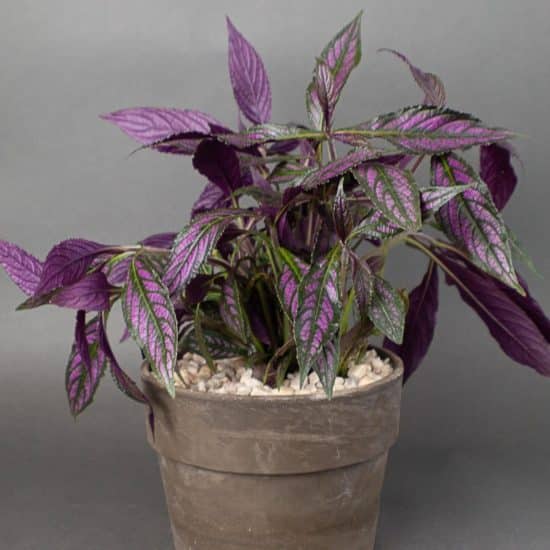
Like other tropical plants, Persian shield can experience the usual gamut of bugs and fungus. Luckily, there are easy ways to prevent and solve all of them.
Pests
Every now and then, spider mites, aphids, or mealybugs might try to feast on your precious Persian shield. If left unchecked, they could cause the leaves to curl, turn yellow, and become distorted. Not a pretty sight!
Aphids are green, black, or other-colored teeny, soft-bodied insects. Spider mites are usually too small for the human eye, but you’ll see their webbing on the undersides of leaves. Mealybugs look like small white bugs or cotton puffs. To spot them, check the undersides of the leaves and the stems.
Solution: First, isolate the affected plant (don’t want those pests spreading, now do we?). Then, give your plant a nice shower with water to remove as many insects as possible. After that, apply insecticidal soap or diluted neem oil on both sides of the leaves, making sure you follow the instructions on the bottle. Reapply a time or two after you don’t see any signs of infestation to get rid of any eggs.
Preventing pests is simple – inspect your plant regularly, especially the undersides of leaves and stems, and keep it healthy by providing proper care. A healthy, strong plant is less likely to attract these pesky invaders.
Root Rot
Your Persian shield loves water (who doesn’t?), but too much of it can lead to root rot. Symptoms include yellowing leaves, a not-so-pleasant smell, and mushy, black, or brown roots. If you see these signs, it’s time for some plant TLC!
Solution: Remove the plant from its pot and get rid of any rotten roots with sterilized scissors. Next, repot the plant in fresh, well-draining soil, and a clean pot with drainage holes. A soil mix that includes perlite, pumice, or LECA will ensure proper aeration and drainage, keeping your plant’s roots nice and healthy.
Prevention: Preventing root rot is all about proper drainage and not overwatering. Wait for the soil to dry one or two inches down before watering again, and use a well-draining soil mix to avoid waterlogged conditions. And there you have it – a happy and healthy Persian shield!
Conclusion
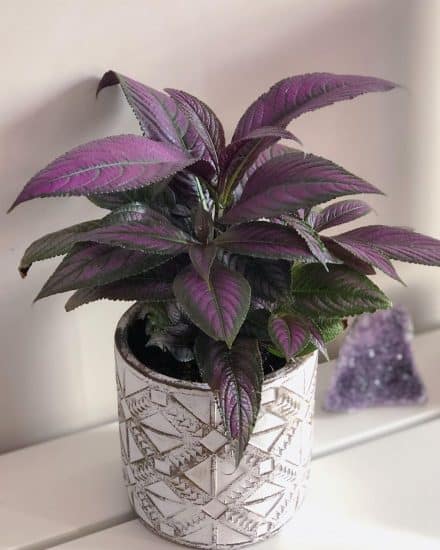
That’s it for our Persian shield care guide!
Strobilanthes dyerianus is a beautiful and exotic indoor plant that’s sure to make an impression in any space. Now that you’re equipped with a wealth of knowledge on how to grow Persian shield, you can expect stunning purple foliage and a healthy, happy plant.
Trust us, your friends will be asking where they can get one too!
We hope this guide has given you everything you need to successfully care for your Persian shield. If you found our guide helpful, don’t hesitate to share it with your friends and fellow plant lovers!
And, as always, feel free to reach out to us with any questions, concerns, or simply to share your Persian shield success story.
Take care, and happy gardening!
FAQ
Do Persian shields come back every year?
Yes! These plants are generally considered tropical, but can thrive as root-hardy perennials in cooler climates. Just make sure you protect them from cold weather, and they’ll keep making their comeback! Remember that some extra care is needed during the winter months, especially if you live in a colder climate. Consider taking a few cuttings from your mother plant at the end of the season to propagate indoors and ensure new plants to transplant once the weather warms up.
Is Persian shield an indoor or outdoor plant?
Persian shield plants are versatile and can be grown as both outdoor and indoor plants. For the best results, give your potted plants bright indirect light, well-draining soil, and a humid environment.
How big does a Persian shield plant get?
Persian shield plants can grow quite large, reaching up to several feet in height when given proper care. Indoors, you can expect your plant to grow anywhere between 2-4 feet tall and 1-2 feet wide. Outdoors, these plants can reach even larger sizes, growing up to 4-8 feet tall and 2-4 feet wide.
Can Persian shield plants thrive outdoors in partial shade?
Yes, they can absolutely thrive outdoors in partial shade. In fact, they love sultry, humid air and generally prefer dappled sunlight rather than full sun, which can be too harsh and cause their leaves to burn.
Sources
- https://www.rhs.org.uk/plants/52694/strobilanthes-dyeriana/details
- https://hort.extension.wisc.edu/articles/persian-shield-strobilanthes-dyerianus/
- https://www.missouribotanicalgarden.org/PlantFinder/PlantFinderDetails.aspx?kempercode=a122
- https://gardeningsolutions.ifas.ufl.edu/plants/ornamentals/persian-shield.html

